河南专升本考试英语语法系列复习专题——动词时态被动语态
各时态的被动语态的基本结构

各时态的被动语态的基本结构一、被动语态的概念及基本用法被动语态是指句子的主语是动作的承受者,而不是执行者。
在英语中,被动语态通常由“be+过去分词”构成,常用于强调动作的承受者或者不知道执行者是谁的情况下。
二、一般现在时的被动语态1.基本结构:am/is/are+过去分词2.使用场景:用于强调动作的承受者或者不知道执行者是谁的情况下。
3.例句:The cake is made by my mother.(蛋糕是我妈妈做的。
)The book is read by me every day.(这本书我每天都会读。
)三、一般过去时的被动语态1.基本结构:was/were+过去分词2.使用场景:用于强调过去某个时间点或事件中发生了什么事情。
3.例句:The letter was written by her yesterday afternoon.(这封信昨天下午被她写了。
)The game was played by the children last night.(孩子们昨晚玩了这个游戏。
)四、一般将来时的被动语态1.基本结构:will be+过去分词2.使用场景:用于强调将来某个时间点或事件中将会发生什么事情。
3.例句:The cake will be made by my mother tomorrow.(明天蛋糕会是我妈妈做的。
)The game will be played by the children this weekend.(这个周末孩子们会玩这个游戏。
)五、现在进行时的被动语态1.基本结构:am/is/are being+过去分词2.使用场景:用于强调正在进行的动作的承受者。
3.例句:The cake is being made by my mother right now.(现在蛋糕正在被我妈妈做。
)The game is being played by the children at the moment.(现在孩子们正在玩这个游戏。
专升本英语语法重点汇总
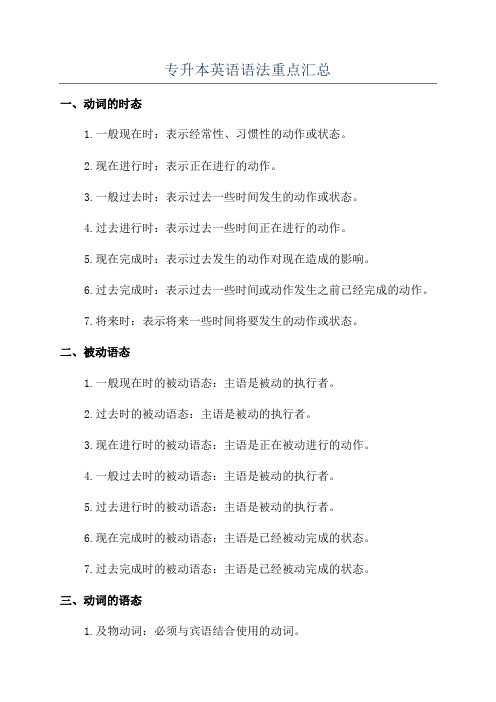
专升本英语语法重点汇总一、动词的时态1.一般现在时:表示经常性、习惯性的动作或状态。
2.现在进行时:表示正在进行的动作。
3.一般过去时:表示过去一些时间发生的动作或状态。
4.过去进行时:表示过去一些时间正在进行的动作。
5.现在完成时:表示过去发生的动作对现在造成的影响。
6.过去完成时:表示过去一些时间或动作发生之前已经完成的动作。
7.将来时:表示将来一些时间将要发生的动作或状态。
二、被动语态1.一般现在时的被动语态:主语是被动的执行者。
2.过去时的被动语态:主语是被动的执行者。
3.现在进行时的被动语态:主语是正在被动进行的动作。
4.一般过去时的被动语态:主语是被动的执行者。
5.过去进行时的被动语态:主语是被动的执行者。
6.现在完成时的被动语态:主语是已经被动完成的状态。
7.过去完成时的被动语态:主语是已经被动完成的状态。
三、动词的语态1.及物动词:必须与宾语结合使用的动词。
2.不及物动词:不需要与宾语结合使用的动词。
四、倒装句1.完全倒装:把助动词或情态动词放在主语前。
2.部分倒装:把助动词或情态动词放在谓语动词前。
五、情态动词1. can:表示能力、许可、可能。
2. could:表示过去的能力、许可、可能。
3. may:表示允许、可能。
4. might:表示过去可能。
5. must:表示推测、必须。
6. shall:表示将来的意愿。
7. should:表示建议、应该。
8. will:表示将来。
9. would:表示过去习惯、愿意。
六、名词1.可数名词:可以用来计数的名词。
2.不可数名词:不可以用来计数的名词。
3.特殊名词变复数形式。
4.特殊名词变单数形式。
七、形容词和副词1.形容词在句中的位置。
2.形容词比较级和最高级。
3.副词在句中的位置。
4.副词比较级和最高级。
五、代词1.主格代词:作为主语的代词。
2.宾格代词:作为宾语的代词。
3.物主代词:表示所属关系的代词。
4.反身代词:表示动作反过来作用于自己的代词。
专升本英语语法时态基础知识点归纳
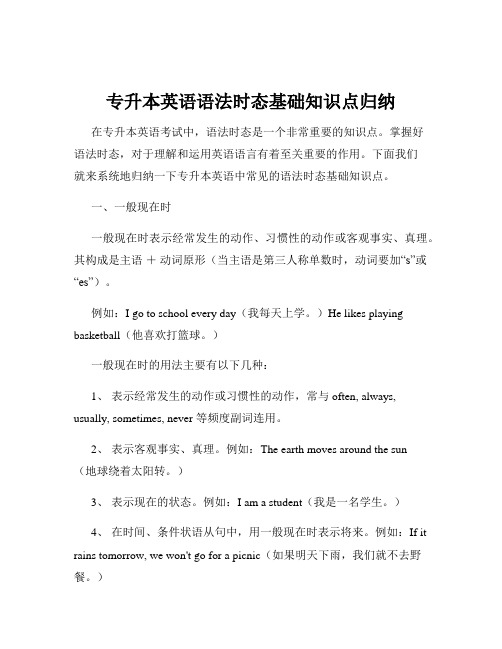
专升本英语语法时态基础知识点归纳在专升本英语考试中,语法时态是一个非常重要的知识点。
掌握好语法时态,对于理解和运用英语语言有着至关重要的作用。
下面我们就来系统地归纳一下专升本英语中常见的语法时态基础知识点。
一、一般现在时一般现在时表示经常发生的动作、习惯性的动作或客观事实、真理。
其构成是主语+动词原形(当主语是第三人称单数时,动词要加“s”或“es”)。
例如:I go to school every day(我每天上学。
)He likes playing basketball(他喜欢打篮球。
)一般现在时的用法主要有以下几种:1、表示经常发生的动作或习惯性的动作,常与 often, always, usually, sometimes, never 等频度副词连用。
2、表示客观事实、真理。
例如:The earth moves around the sun(地球绕着太阳转。
)3、表示现在的状态。
例如:I am a student(我是一名学生。
)4、在时间、条件状语从句中,用一般现在时表示将来。
例如:If it rains tomorrow, we won't go for a picnic(如果明天下雨,我们就不去野餐。
)二、一般过去时一般过去时表示过去发生的动作或存在的状态。
其构成是主语+动词的过去式。
例如:I played football yesterday(我昨天踢足球了。
)一般过去时的用法主要有以下几种:1、表示过去某个时间发生的动作或存在的状态,常与表示过去的时间状语连用,如 yesterday, last week, last year, ago 等。
2、表示过去经常或反复发生的动作,常与 often, always 等频度副词连用。
三、一般将来时一般将来时表示将来要发生的动作或存在的状态。
其构成有多种形式,常见的有“will +动词原形”和“be going to +动词原形”。
动词时态和被动语态用法详细全面归纳总结
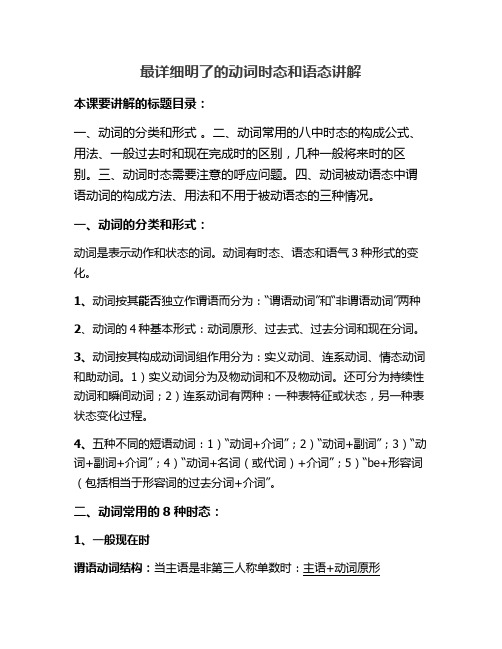
最详细明了的动词时态和语态讲解本课要讲解的标题目录:一、动词的分类和形式。
二、动词常用的八中时态的构成公式、用法、一般过去时和现在完成时的区别,几种一般将来时的区别。
三、动词时态需要注意的呼应问题。
四、动词被动语态中谓语动词的构成方法、用法和不用于被动语态的三种情况。
一、动词的分类和形式:动词是表示动作和状态的词。
动词有时态、语态和语气3种形式的变化。
1、动词按其能否独立作谓语而分为:“谓语动词”和“非谓语动词”两种2、动词的4种基本形式:动词原形、过去式、过去分词和现在分词。
3、动词按其构成动词词组作用分为:实义动词、连系动词、情态动词和助动词。
1)实义动词分为及物动词和不及物动词。
还可分为持续性动词和瞬间动词;2)连系动词有两种:一种表特征或状态,另一种表状态变化过程。
4、五种不同的短语动词:1)“动词+介词”;2)“动词+副词”;3)“动词+副词+介词”;4)“动词+名词(或代词)+介词”;5)“be+形容词(包括相当于形容词的过去分词+介词”。
二、动词常用的8种时态:1、一般现在时谓语动词结构:当主语是非第三人称单数时:主语+动词原形当主语是第三人称单数时:主语+动词的第三人称单数形式(动词的词尾要加-S)(规则:一般的动词词尾+S.以sh/ch/s/x结尾的词+es.以辅音字母Y结尾的把Y变成i,+es.辅音字母+o结尾的+es.) 。
一般现在时的用法:1)表示现在的习惯,经常发生的动作或存在的状态。
如:I often get up early in the morning .He likes reading in the afternoon.2)表示客观事实或真理及自然现象,此用法即使出现在过去语境中,也用一般现在时态。
如:The sun rises in the east.3)用于here,there开头的倒装句中,一般现在时表示正在发生的动作或存在的状态。
如:There goes the bell. Here comes the bus.2、一般过去时态谓语动词构成:主语+动词的过去式动词的过去式是在动词原形的基础上变化而来的,一般是在词尾加上ed.动词的过去式可分为规则动词和不规则动词.规则动词的过去式变化如下:一般情况下,动词词尾加 -ed ,如: work-ed, play-ed ,want-ed. Act-ed 等词。
河南专升本语法(一)动词时态语态(学生版)

语法(一)—动词时态语态语法考点分析:从句会占到7-9分,非谓语动词6-8分,这两块基本是15分;虚拟语气2-3分;时态与语态(主要是完成时)会有1分或情态动词的完成体1分,主谓一致1分。
从句中,重要考点是定语从句,定语从句会占到从句中3-4分,其中which引导的非限制性定语从句、只能用that引导定语从句必考;然后是名词性从句,其中主语从句中whether 与if 的区别、whoever的用法、that与what、whatever的区别是主要考点;还有that引导的同位语从句;状语从句中主要是as引导的让步状语从句、as(so) long as\unless\in case\since 的含义及用法、 no sooner…than…\ hardly…when…\ not…until…\ however的用法、比较级中的倍数问题等是必考的。
非谓语动词中现在分词与过去分词作状语、定语与表语的区别是必考的重点。
There is no good/use/point/sense doing…, It is no good /use doing…句型、admit, appreciate, avoid, can’t help, consider, delay, enjoy, escape, mind, recall, resent, resist,, risk, suggest等动词后跟动名词、分词作状语与分词独立结构的区别虚拟语气,if引导一般虚拟条件句中对过去的假设、用should表虚拟、常用的虚拟语气句型:would rather, had rather, would as soon、It is (high/ about ) time(是……时候了)、动词wish后的虚拟语气、but for, lest, if only后的虚拟语气是重要考点。
主谓一致考点解析:就远法当主语与with, along with, accompanied by, in addition to, together with, including, as well as, like, besides, rather than。
河南专升本考试英语语法系列复习专题——动词时态,被动语态

河南专升本考试英语语法系列复习专题——动词时态,被动语态一、普通如今时1.普通如今时表示经常发生、适应性动作、客观真理、科学事实、格言,目前的特征、状态、能力等。
2.主句是普通未来时,时刻、条件状语从句中用普通如今时表示未来。
如:I’ll go there after I finish my work./ If it rains tomorrow,I won’t go there.3.在以here,there开头的句子里,go,come等少数动词的普通在时表示正在发生的动作。
例如:There goes the bell.铃响了。
There comes the bus.汽车来了。
Here she comes.她来了。
二、如今举行时1.表示正在举行的动作。
2.表示按打算安排即将发生的动作。
例如:She is leaving for Beijing.她要去北京。
He is working as a teacher tomorrow.从改日起他要做老师。
My father is coming to see me this Saturday.那个星期六我父亲要来看我。
3.代替普通如今时,描绘更加生动。
例如:The Changjiang River is flowing into the east.江水滚滚向东流。
The sun is rising in the east.太阳从东方冉冉升起。
4.大多数动词可用于举行时,但也有点动词别用于举行时。
常见的有:exist,live,understand,mean,owe,belongto ,know,doubt,suppose,remember,forget,believe,trust,want,wish,refuse,like,hate,dislike,prefer,mind,hope 等。
三、如今完成时1.表示过去发生的动作对如今产生的妨碍或结果,或讲话时已完成的动作。
河南专升本考试英语语法系列复习专题——动词时态,被动语态

一、一般现在时1.一般现在时表示经常发生、习惯性动作、客观真理、科学事实、格言,目前的特征、状态、能力等。
2.主句是一般将来时,时间、条件状语从句中用一般现在时表示将来。
如:I’ll go there after I finish my work./ If it rains tomorrow,I won’t go there.3.在以here,there开头的句子里,go,come等少数动词的一般在时表示正在发生的动作。
例如:There goes the bell.铃响了。
There comes the bus.汽车来了。
Here she comes.她来了。
二、现在进行时1.表示正在进行的动作。
2.表示按计划安排即将发生的动作。
例如:She is leaving for Beijing.她要去北京。
He is working as a teacher tomorrow.从明天起他要做老师。
My father is coming to see me this Saturday.这个星期六我爸爸要来看我。
3.代替一般现在时,描绘更加生动。
例如:The Changjiang River is flowing into the east.江水滚滚向东流。
The sun is rising in the east.太阳从东方冉冉升起。
4.大多数动词可用于进行时,但也有些动词不用于进行时。
常见的有:exist,live,understand,mean,owe,belong to ,know,doubt,suppose,remember,forget,believe,trust,want,wish,refuse,like,hate,dislike,prefer,mind,hope等。
三、现在完成时1.表示过去发生的动作对现在产生的影响或结果,或说话时已完成的动作。
例如:I have finished the report./ She has cleand the room.2.表示从过去开始,待续到现在的动作或状态,往往和“for…”, “since…”表述的一段时间状语连用。
动词的被动语态与被动语态的用法与被动语态的构成

动词的被动语态与被动语态的用法与被动语态的构成被动语态是英语中的一种语法形式,用来表示动作的接受者在句中的主语位置,而执行动作的人或物成为句子的宾语。
被动语态由助动词“be”(am, is, are, was, were)加动词的过去分词构成,使用被动语态可以突出动作的接受者,强调某些物或人所承受的动作或状况。
被动语态在写作和口语中经常被使用,但是在使用被动语态时,我们需要注意使用的时机和方法。
一、被动语态的构成被动语态由助动词“be”和动词的过去分词构成,具体构成方式如下:1. 当主动句的时态为一般现在时(Simple Present Tense)时,“be”的形式为is或are。
例如:He repairs computers.(主动语态)Computers are repaired by him.(被动语态)2. 当主动句的时态为一般过去时(Simple Past Tense)时,“be”的形式为was或were。
例如:She wrote the letter.(主动语态)The letter was written by her.(被动语态)3. 当主动句的时态为一般将来时(Simple Future Tense)时,介词“will”变为“be going to”,之后加动词的过去分词。
例如:They will clean the room.(主动语态)The room is going to be cleaned by them.(被动语态)4. 当主动句的时态为现在完成时(Present Perfect Tense)时,“be”的形式为has或have。
例如:I have finished my homework.(主动语态)My homework has been finished by me.(被动语态)需要注意的是,有些及物动词的过去分词形式与其原形相同,此时构成被动语态要使用助动词“am, is, are, was, were”和“being”。
英语动词时态的被动语态

英语动词时态的被动语态下面是CN人才网小编整理的英语动词时态的被动语态,一起来看看吧。
种时态的被动语态被动语态的构成be过去分词1一般现在时的被动语态am / is / are过去分词2一般过去时的被动语态was / were过去分词3现在进行时的被动语态am / is / are +being过去分词4过去进行时的被动语态was / were +being过去分词5现在完成时的被动语态have / has been过去分词6过去完成时的被动语态had been过去分词7将来完成时的被动语态will / shall have been过去分词8一般将来时的被动语态will / shall be过去分词9过去将来时的被动语态would / should be过去分词为了便于理解,请看以下几个例子:We are given a lot of homework to do.我们有很多作业要做。
They were given a warm send-off.他们受到热烈的欢送。
I think we are being followed.我想有人在跟踪我们。
They told me that the case was being investigated.他们告诉我案子正在调查。
The documents for which they were searching have been recovered.他们找寻的文件已找到了。
He asked if Mary had been sent to hospital.他问玛丽是否已被送进医院。
Check carefully, so any mistakes will be caught.仔细检查一遍,把所有错误都找出来。
He knew he would be punished for it. 他知道他会为此受到惩罚。
高考英语基础语法:动词时态与被动语态详解
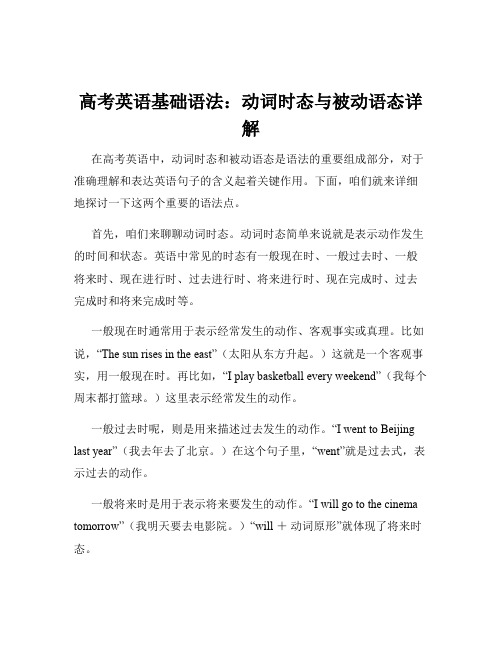
高考英语基础语法:动词时态与被动语态详解在高考英语中,动词时态和被动语态是语法的重要组成部分,对于准确理解和表达英语句子的含义起着关键作用。
下面,咱们就来详细地探讨一下这两个重要的语法点。
首先,咱们来聊聊动词时态。
动词时态简单来说就是表示动作发生的时间和状态。
英语中常见的时态有一般现在时、一般过去时、一般将来时、现在进行时、过去进行时、将来进行时、现在完成时、过去完成时和将来完成时等。
一般现在时通常用于表示经常发生的动作、客观事实或真理。
比如说,“The sun rises in the east”(太阳从东方升起。
)这就是一个客观事实,用一般现在时。
再比如,“I play basketball every weekend”(我每个周末都打篮球。
)这里表示经常发生的动作。
一般过去时呢,则是用来描述过去发生的动作。
“I went to Beijing last year”(我去年去了北京。
)在这个句子里,“went”就是过去式,表示过去的动作。
一般将来时是用于表示将来要发生的动作。
“I will go to the cinema tomorrow”(我明天要去电影院。
)“will +动词原形”就体现了将来时态。
现在进行时表示正在进行的动作。
“I am reading a book now”(我现在正在读书。
)“be +动词的现在分词”构成现在进行时。
过去进行时用于描述过去某个时刻正在进行的动作。
“I was watching TV at 8 o'clock yesterday evening”(昨天晚上 8 点我正在看电视。
)将来进行时相对用得少一些,它表示将来某个时刻正在进行的动作。
比如,“This time next week, I will be having a meeting”(下周这个时候,我将正在开会。
)现在完成时表示过去发生的动作对现在造成的影响或结果。
“I have finished my homework”(我已经完成了作业。
英语语法被动语态知识点梳理

英语语法被动语态知识点梳理在英语语法中,被动语态是一个重要且常用的语法点。
理解和掌握被动语态对于准确、流畅地表达意思以及提高英语语言能力都有着至关重要的作用。
下面咱们就来详细梳理一下被动语态的相关知识。
一、被动语态的构成被动语态的基本构成是“be +过去分词”。
其中,“be”动词要根据不同的时态和主语进行变化,过去分词则保持不变。
比如,一般现在时的被动语态是“am/is/are +过去分词”,一般过去时是“was/were +过去分词”,现在进行时是“am/is/are + being +过去分词”,过去进行时是“was/were + being +过去分词”,现在完成时是“have/has + been +过去分词”,过去完成时是“had + been +过去分词”等等。
举几个例子帮助大家理解:“ The book is written by him ”(一般现在时的被动语态)“ The tree was cut down yesterday ”(一般过去时的被动语态)“ The problem is being discussed now ”(现在进行时的被动语态)“ The work had been finished before he came ”(过去完成时的被动语态)二、被动语态的使用场景1、不知道或没必要指出动作的执行者当我们关注的是动作本身而不是执行者时,就会使用被动语态。
例如:“The window was broken ”(不知道是谁打破了窗户)2、强调动作的承受者为了突出动作的承受者,会使用被动语态。
比如:“This song is loved by many people ”(强调很多人喜欢这首歌,而不是强调谁让很多人喜欢这首歌)3、出于礼貌或委婉在某些情况下,使用被动语态可以使表达更委婉、更礼貌。
比如:“It is suggested that you should come earlier ”(用被动语态比直接说“ We suggest that you should come earlier ”更委婉)三、主动语态变被动语态的方法1、把主动语态中的宾语变成被动语态的主语。
河南中考英语(人教)复习-语法十一-动词的时态与被动语态-ppt课件

tomorrow, so an early arrival at the station
.
A.advises C
B.is advised D
.is advising
.was advised
14
3.(2015·河南中考)Now it's much easier to shop online when your order is
13
1.(2017·河南中考)—Why are you leaving your job?
—I can't stand it any longer. I
always
A.am; asking
B.am; asked
to work overtime.
C.was; asking D.was; asked 2.(2016·河南中考)We are going to take the highspeed train to Xi'an
河南语法十一 动词的时态与被动语态
1
考点一 动词的时态 1.一般现在时 表示经常性、习惯性的动作或表示客观真理。常与often, usually, always等 词语连用。 She often works on weekends.她经常在周末工作。 There are four seasons in a year.一年有四个季节。
2
2.一般过去时 表示过去发生的动作。be动词的一般过去时为was, were;实义动词的一般 过去时为动词的过去式。常与just now, yesterday, last week, ago等表示过 去的时间状语连用。 Who did you see at the meeting yesterday?你在昨天的会议上看见了谁?
2018年河南专升本英语语法16种时态汇总
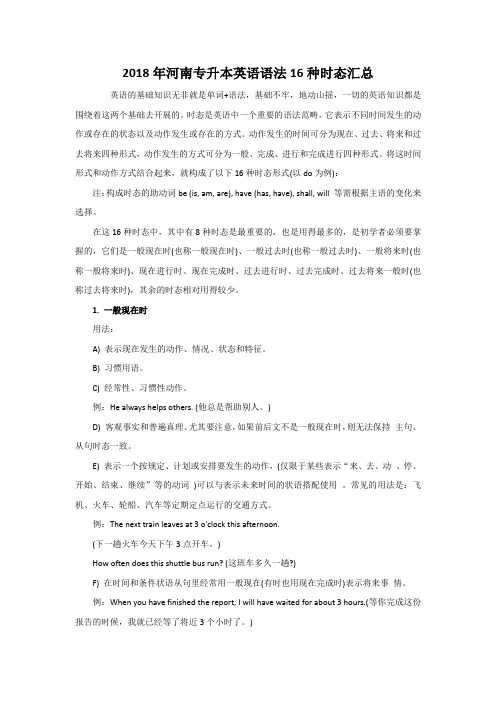
2018年河南专升本英语语法16种时态汇总英语的基础知识无非就是单词+语法,基础不牢,地动山摇,一切的英语知识都是围绕着这两个基础去开展的。
时态是英语中一个重要的语法范畴,它表示不同时间发生的动作或存在的状态以及动作发生或存在的方式。
动作发生的时间可分为现在、过去、将来和过去将来四种形式,动作发生的方式可分为一般、完成、进行和完成进行四种形式。
将这时间形式和动作方式结合起来,就构成了以下16种时态形式(以do为例):注:构成时态的助动词be (is, am, are), have (has, have), shall, will 等需根据主语的变化来选择。
在这16种时态中,其中有8种时态是最重要的,也是用得最多的,是初学者必须要掌握的,它们是一般现在时(也称一般现在时)、一般过去时(也称一般过去时)、一般将来时(也称一般将来时)、现在进行时、现在完成时、过去进行时、过去完成时、过去将来一般时(也称过去将来时),其余的时态相对用得较少。
1. 一般现在时用法:A) 表示现在发生的动作、情况、状态和特征。
B) 习惯用语。
C) 经常性、习惯性动作。
例:He always helps others. (他总是帮助别人。
)D) 客观事实和普遍真理。
尤其要注意,如果前后文不是一般现在时,则无法保持主句、从句时态一致。
E) 表示一个按规定、计划或安排要发生的动作,(仅限于某些表示“来、去、动、停、开始、结束、继续”等的动词)可以与表示未来时间的状语搭配使用。
常见的用法是:飞机、火车、轮船、汽车等定期定点运行的交通方式。
例:The next train leaves at 3 o'clock this afternoon.(下一趟火车今天下午3点开车。
)How often does this shuttle bus run? (这班车多久一趟?)F) 在时间和条件状语从句里经常用一般现在(有时也用现在完成时)表示将来事情。
河南专升本英语语法

河南专升本英语语法
河南专升本英语语法考试主要考察学生对英语基础语法的掌握程度,考试难度相当于大学英语四级的水平。
以下是河南专升本英语语法考试中常见的一些语法知识点:
1. 时态和语态:包括一般现在时、一般过去时、现在进行时、过去进行时、将来时(包括will和be going to)、被动语态等。
2. 虚拟语气:包括与现在事实相反、与过去事实相反、与将来事实相反的虚拟语气。
3. 非谓语动词:包括动词不定式、动名词和分词等。
4. 从句:包括名词性从句(主语从句、宾语从句、表语从句)、定语从句和状语从句等。
5. 倒装句:包括部分倒装和完全倒装。
6. 强调句:包括强调谓语、强调主语和强调宾语等。
7. 主谓一致:包括单数主语和复数主语的情况。
8. 情态动词:包括can、could、may、might、must、need等情态动词的用法。
9. 介词和连词:包括常用介词和连词的用法,如in、on、at、for等。
10. 形容词和副词:包括形容词和副词的比较级和最高级的用法,以及修饰名词和修饰动词的情况。
以上是河南专升本英语语法考试中常见的一些知识点,备考时可以结合真题进行练习,掌握常见的考点和题型,提高自己的语法水平。
10.河南专升本英语-时态语态

一般
现在 do/does
过去 did
将来
过去将来
will do
would do
am/is/are going to do was/were going to do
进行
am/is/are doing
was/were doing
will be doing
would be doing
完成 have/has done had done
【C】 【考点】and前为祈使句, 符合祈使句+and/or+主语+will do的句型
四. 现在进行时
1.定义:现在或现阶段正在进行的动作或状态 2.结构:am/is/are+现在分词(doing) 3.考点:always,forever, constantly与现在进行时 连用表喜爱或厌恶等情感
【例题】 The train _____ in New York at eight o’clock tonight.
A. arrives
B. will arriving
C. is going arrive
D. arrived
【A】 【考点】安排或计划好了的动作,尤指交通时刻表,无论 是否发生一律使用一般现在时
【例题】 Turn on the television or open a magazine and you _____advertisement showing happy, balanced families. A. are often seeing B. will be finding C. will often see D. have often see
考点一:主将/祈/情从现
在时间/ 条件状语从句中:
3英语语法—动词的被动语态
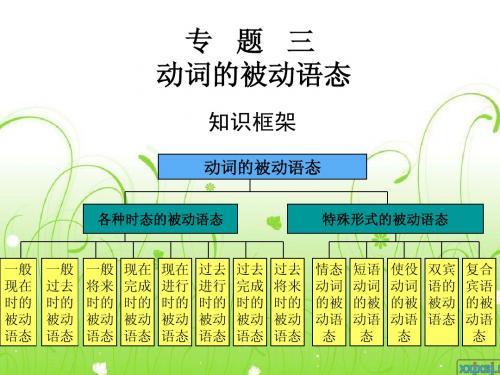
知识框架
动词的被动语态
各种时态的被动语态 特殊形式的被动语态
一般 现在 时的 被动 语态
一般 过去 时的 被动 语态
一般 将来 时的 被动 语态
现在 完成 时的 被动 语态
现在 进行 时的 被动 语态
过去 进行 时的 被动 语态
过去 完成 时的 被动 语态
过去 将来 时的 被动 语态
② 表示需要突出或强调动作的承受者时 These picture _____ when we took a trip to Mount Tai. A .took B .take C .were taken D . will be taken 【解析】C。语意为“这些照片是我们去泰山旅游时照的”。为了强调动作 的承 受者,本题应使用被动语态,故正确答案为C。
Orange are not grown in the north. 北方不种橘子。 Is this book written by a young man? 这本书是由一个年轻人写的吗?
考点3
各种时态的被动语态。
一 般 进 行 am/is/are+being+p.p. was/were+being+p.p. ———— ———— 完 成 have/has+been+p.p. had+been+p.p. ———— ————
二、易错点突破
!易错点一 只有及物动词或是“不及物动词+介词”构成的短语才能用被动语 态。 ★不及物动词、系动词不能接宾语,故不能用被动语态。 • Cotton feels soft. 棉花摸起来很软。 • The roses smell sweet. 这些玫瑰花闻起来很香。
专升本英语动词和语态的重点
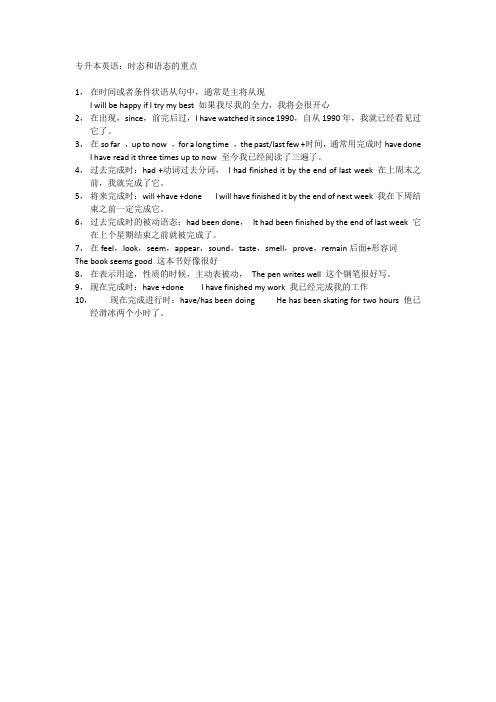
专升本英语:时态和语态的重点1,在时间或者条件状语从句中,通常是主将从现I will be happy if I try my best 如果我尽我的全力,我将会很开心2,在出现,since,前完后过,I have watched it since 1990,自从1990年,我就已经看见过它了。
3,在so far ,up to now ,for a long time ,the past/last few +时间,通常用完成时have doneI have read it three times up to now 至今我已经阅读了三遍了。
4,过去完成时:had +动词过去分词,I had finished it by the end of last week 在上周末之前,我就完成了它。
5,将来完成时:will +have +done I will have finished it by the end of next week 我在下周结束之前一定完成它。
6,过去完成时的被动语态:had been done,It had been finished by the end of last week 它在上个星期结束之前就被完成了。
7,在feel,look,seem,appear,sound,taste,smell,prove,remain后面+形容词The book seems good 这本书好像很好8,在表示用途,性质的时候,主动表被动,The pen writes well 这个钢笔很好写。
9,现在完成时:have +done I have finished my work 我已经完成我的工作10,现在完成进行时:have/has been doing He has been skating for two hours 他已经滑冰两个小时了。
专升本英语的11种语态

专升本英语的11种语态
专升本英语的11种语态包括:
1.主动语态:表示主语是动作的执行者。
2.被动语态:表示主语是动作的承受者。
3.进行时态:表示动作正在进行中。
4.完成时态:表示动作已经完成。
5.过去进行时态:表示过去某个时间正在进行的动作。
6.过去完成时态:表示过去某个时间之前已经完成的动作。
7.将来进行时态:表示将来某个时间正在进行的动作。
8.将来完成时态:表示将来某个时间之前已经完成的动作。
9.现在完成进行时态:表示动作从过去开始一直持续到现在,并且仍在进行中。
10.过去完成进行时态:表示过去某个时间之前开始一直持续到该时间的动作,并且仍在进行中。
11.将来完成进行时态:表示将来某个时间之前开始一直持续到该时间的动作,并且仍在进行中。
以上信息仅供参考,具体内容可能会根据教材版本和教学要求有所不同,建议查阅英语教材或咨询英语老师获取更准确的信息。
河南专升本英语语法复习
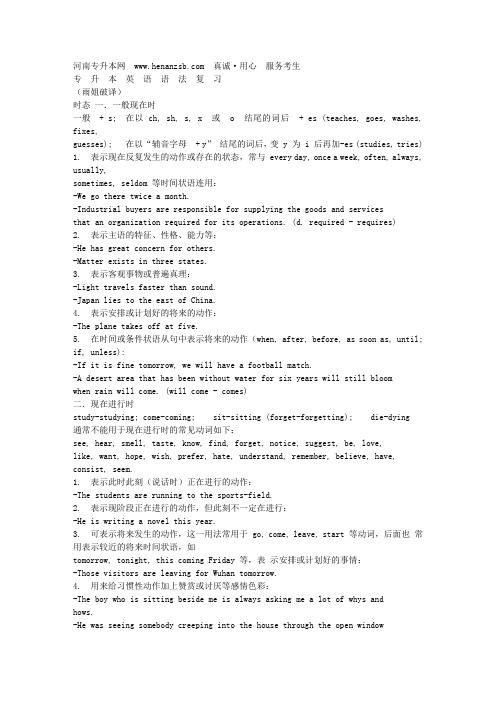
河南专升本网 真诚·用心服务考生专升本英语语法复习(雨姐破译)时态一.一般现在时一般 + s; 在以 ch, sh, s, x 或 o 结尾的词后 + es (teaches, goes, washes, fixes,guesses); 在以“辅音字母+ y” 结尾的词后,变 y 为 i 后再加-es (studies, tries) 1. 表示现在反复发生的动作或存在的状态,常与 every day, once a week, often, always, usually,sometimes, seldom 等时间状语连用:-We go there twice a month.-Industrial buyers are responsible for supplying the goods and servicesthat an organization required for its operations. (d. required - requires)2. 表示主语的特征、性格、能力等:-He has great concern for others.-Matter exists in three states.3. 表示客观事物或普遍真理:-Light travels faster than sound.-Japan lies to the east of China.4. 表示安排或计划好的将来的动作:-The plane takes off at five.5. 在时间或条件状语从句中表示将来的动作(when, after, before, as soon as, until; if, unless):-If it is fine tomorrow, we will have a football match.-A desert area that has been without water for six years will still bloomwhen rain will come. (will come - comes)二.现在进行时study-studying; come-coming; sit-sitting (forget-forgetting); die-dying通常不能用于现在进行时的常见动词如下:see, hear, smell, taste, know, find, forget, notice, suggest, be, love,like, want, hope, wish, prefer, hate, understand, remember, believe, have, consist, seem.1. 表示此时此刻(说话时)正在进行的动作:-The students are running to the sports-field.2. 表示现阶段正在进行的动作,但此刻不一定在进行:-He is writing a novel this year.3. 可表示将来发生的动作,这一用法常用于 go, come, leave, start 等动词,后面也常用表示较近的将来时间状语,如tomorrow, tonight, this coming Friday 等,表示安排或计划好的事情:-Those visitors are leaving for Wuhan tomorrow.4. 用来给习惯性动作加上赞赏或讨厌等感情色彩:-The boy who is sitting beside me is always asking me a lot of whys andhows.-He was seeing somebody creeping into the house through the open windowlast night.三.现在完成时1.表示动作现在刚完成:-His son has finished his homework.2. 表示过去做的动作对现在仍有影响:-It's so cold in here. Who has broken the window?本资料来源于互联网上,版权归作者所有,仅供考生参考学习,请自觉在下载 24 小时内删除。
专转本英语语法系列之被动语态
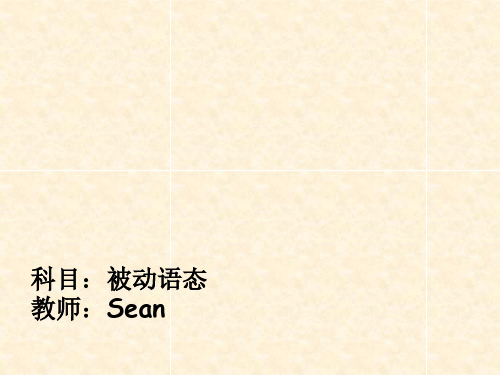
被动语态 Good care is taken of the children by the
短语动词应作为一个整体看待,变成被动语态时不能丢掉构成短
语动词的介词、副词或名词+介词等成分。
三、被动语态的几种特殊结构
除了助动词be加及物动词的过去分词这种最常见的被动语态结构外,还有一些特 殊结构。
2. 短语动词的被动语态结构。所谓短语动词,指的是某些动词和其 它词类,如介词、副词、或名词+介词构成的固定词组。如:
主动语态 We will put off the meeting till Friday.
被动语态 The meeting will be put off till Friday.
三、被动语态的几种特殊结构
除了助动词be加及物动词的过去分词这种最常见的被动语态结构外,还有一些特 殊结构。
2副词、或名词+介词构成的固定词组。如:
主动语态 The nurse takes good care of the children.
被动语态 The children are taken good care of.
三、被动语态的几种特殊结构
除了助动词be加及物动词的过去分词这种最常见的被动语态结构外,还有一些特 殊结构。
2. 短语动词的被动语态结构。所谓短语动词,指的是某些动词和其 它词类,如介词、副词、或名词+介词构成的固定词组。如:
科目:被动语态 教师:Sean
被动语态
英语动词有主动和被动两种语态。主动语态(active voice)表示主语是动作的执行
者,被动语态(passive voice)表示主语是动作的承受着。
- 1、下载文档前请自行甄别文档内容的完整性,平台不提供额外的编辑、内容补充、找答案等附加服务。
- 2、"仅部分预览"的文档,不可在线预览部分如存在完整性等问题,可反馈申请退款(可完整预览的文档不适用该条件!)。
- 3、如文档侵犯您的权益,请联系客服反馈,我们会尽快为您处理(人工客服工作时间:9:00-18:30)。
一、一般现在时1.一般现在时表示经常发生、习惯性动作、客观真理、科学事实、格言,目前的特征、状态、能力等。
2.主句是一般将来时,时间、条件状语从句中用一般现在时表示将来。
如:I’ll go there after I finish my work./ If it rains tomorrow,I won’t go there.3.在以here,there开头的句子里,go,come等少数动词的一般在时表示正在发生的动作。
例如:There goes the bell.铃响了。
There comes the bus.汽车来了。
Here she comes.她来了。
二、现在进行时1.表示正在进行的动作。
2.表示按计划安排即将发生的动作。
例如:She is leaving for Beijing.她要去北京。
He is working as a teacher tomorrow.从明天起他要做老师。
My father is coming to see me this Saturday.这个星期六我爸爸要来看我。
3.代替一般现在时,描绘更加生动。
例如:The Changjiang River is flowing into the east.江水滚滚向东流。
The sun is rising in the east.太阳从东方冉冉升起。
4.大多数动词可用于进行时,但也有些动词不用于进行时。
常见的有:exist,live,understand,mean,owe,belong to ,know,doubt,suppose,remember,forget,believe,trust,want,wish,refuse,like,hate,dislike,prefer,mind,hope等。
三、现在完成时1.表示过去发生的动作对现在产生的影响或结果,或说话时已完成的动作。
例如:I have finished the report./ She has cleand the room.2.表示从过去开始,待续到现在的动作或状态,往往和“for…”, “since…”表述的一段时间状语连用。
例如:He has learned English for six years./ They have worked here since they left college.3.现在完成时与一般过去时的区别:1)用两种时态来表述发生在过去的某一动作,现在完成时强调这一过去动作对现在产生的影响或结果,而一般过去时只表达过去的动作或状态,和现在关系不大。
例如:She has cleaned the room.It’s very clean now.(此句has cleaned就不能改为cleaned.一是因为cleaned与现状无关,二是因为一般过去时不可突然跳到It’s…这样的一般现在时。
)2)汉语中的“了”、“过”、“曾”等词常用完成表达,如:I have seen that film.(我看过那部电影了。
)但是如果是在特定的过去时间“看了”、“做过”,就不可用完成时而必须用一般过去进来表达。
例如:When did you see that film? I saw it yesterday.(你什么时候看了那部电影?我昨天看的。
)不能说:When have you seen that film?I have seen it yesterday.4.表示“曾经到过某地(人已回来)”用“have/has been to”,表示“到某地去了(还未回来)”用“have/has gone to”.例如:——Where is Li Hua? -He has gone to the reading-room.——She knows a lot about Shanghai.-She has been there.5.短暂动词(即瞬间动词),join,lose,buy,borrow,leave,go,come,arrive,die,marry,finish,complete,begin,start,break out等,在完成时态中,其肯定式不能和表示一段时间的状语连用。
例如不能说:He has finished the work for three hours.要翻译“他已完成工作三小时了。
”可采用1)“ago法”:He finished the work three hours ago.2)“延续法”:He has been through(with)the work for three hours.3)“since法”:It is/has been three hours since he finished the work.四、现在完成进行时1.用来表示从过去某一时刻开始一直持续到现在(或今后还要继续一去)的动作。
例如:He has been doing the maths problems since 8:00./ It has been raining for two days.2.凡是不能用于现在进行时的动词均不能用于现成完成进行时。
五、一般过去时表达特定的过去时间内发生的动作或存在的状况,或过去某一时间内经常发生或反复发生的动作或行为。
六、过去进行时1.表示过去某一时刻或某一段时间内正在进行的动作(这一过去时间须用时间状语表示)。
例如:He was preparing his lecture all day yesterday.2.表示动作在另一过去动作发生时进行。
例如:They were still working when I left.3.用在两个过去进行时动作同时发生。
例如:I was writing while he was watching TV.4.表示过去将来动作。
例如:He said she was arriving the next day.七、过去完成时1.表示在过去某一时间以前已经完成的动作。
例如:He had shut the door before the dog came up./ Everything had been all right up till this morning.2.表示动作或状态从过去某个时刻开始一直延续到另一个过去时刻才完成,甚至还要继续下去。
例如:At the age of ten,he had learned 500 English words.He had been ill for a week when we learned about it.3.常用hope,expect,think,intend,want,suppose等动词的过去完成时来表示未实现的希望、打算或意图。
例如:We had expected that you would be able to win the match.八、一般将来时一般将来时表示将来要发生的动作和存在的状况。
有下列一些形式:1.will/shall do (侧重将来行为,不突出计划安排去做某事)2.be going to do (主观上打算或客观上可能发生)3.be doing (按计划将要发生,常和表示最近的将来时间连用)4.be about to do (按计划即将发生)九、将来完成时用来表示在将来某个时刻(前)将完成的动作。
常和by短语,when,before引起的时间状语连用。
例如:We will have finished senior Book 2 by the end of this term.时态考点分析1.——Can I join your club,dad?——You can when you______a bit older.A.getB.will getC.are gettingD.will have got析:“You can”是将来意,when引导的时间状语从句要用一般现在时表将来所以此题答案为A.2.——Oh,it’s you!I______you.——I’ve just had my hair cut and I’m wearing new glasses.A.didn’t recognizeB.hadn’t recognizedC.haven’t recognizedD.don’t recongnize析:从“Oh,it’s you!”可知说话时已认出对方。
“没有认出”是在此之前为过去情况,所以应选A.3.I don’t think Jim saw me;he______into space.A.just staredB.was just staringC.has just staredD.had just stared析:在空白处应选一个与“saw”相配,能解释Jim didn’t see me 这一原因的选项,只有着眼于A、B。
若选A不能体观他“当时正在做”某事,故排除A而选B。
这样因为“他正在望宇宙天空”所以“未看到我”。
4.——______my glasses?——Yes,I saw them on your bed a minute ago.A.Do you seeB.Had you seenC.Would you seeD.Have you seen析:现在完成时可表过去发生的事情对现在产生的影响或结果,问话人以这样的时态发问可作现焦急的心情。
故答案为D。
5.You don’t need to describe her.I______her several times.A.had metB.have metC.metD.meet析:答案B。
道理同4。
6.——Do you know our town at all?——No,this is the first time I______here.A.wasB.have beenC.cameD.am going析:根据thi s/it is the first/second/…time sb.has done sth.句型,可定答案为B。
又如:This is the second time he has visited the Great Wall.7.I don’t really work here.I______until the new secretary arrives.A.just help outB.have just helped outC.am just helping outD.will just help out析:根据I don’t really work here.以及…until the new secretary arrives,可知说话人所要做的事是计划安排行为,C、D两个选项都表将来动作,但D非计划安排,C则体现按计划去做,所以此题答案为C。
